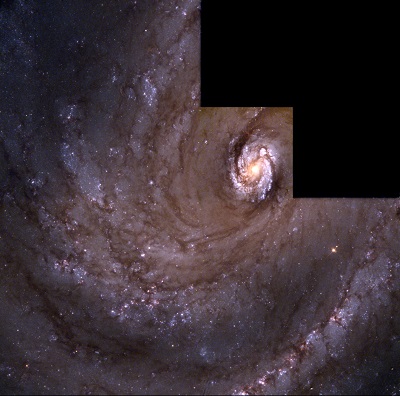M100, mag. +9.5, is a spiral galaxy located in the southern part of the constellation of Coma Berenices. It's one of the brightest members of the Virgo cluster of galaxies and appears almost face-on from our perspective. It exhibits prominent well-defined spiral arms and is therefore regarded as a grand design spiral. Other notable galaxies that fall into this category are M51, M74, M81 and M101.
M100 was discovered, along with M98 and M99, by Pierre Méchain on March 15, 1781. Charles Messier subsequently observed all three objects and added them to his catalogue on April 13, 1781. He described the galaxy as faint without stars. It was not until 1850 that its spiral nature was first detected by Ango-Irish astronomer William Parsons, the 3rd Earl of Rosse. He included it in his list of 14 spiral nebulae.
Finding the area of sky where M100 is positioned is not difficult once familiar with the location of the Virgo cluster. The cluster centre is positioned close to supergiant elliptical galaxy M87 and about halfway along a line connecting Denebola (β Leo - mag. +2.1) with Vindemiatrix (ε Vir - mag. +2.8). M100 is towards the northern section of the group, 2 degrees southeast of star 11 Comae Berenices (mag. +4.7).


Finder Chart for M100 - pdf format (credit:- freestarcharts)
At mag. +9.5, M100 is within the range of 7x50 or 10x50 binoculars. However, since the galaxy appears face-on it suffers from a low surface brightness and therefore is a difficult object. It's easier to spot with larger 20x80 binoculars or small telescopes, where it appears as a faint hazy patch of light with an uneven texture. Medium size 200mm (8-inch) scopes reveal a bright core surrounded by an envelope of shady nebulosity. With larger amateur instruments some dust structures are visible, but only on dark nights of excellent seeing. In total, M100 covers 7.5 x 6.1 arc minutes of apparent sky, although visually it appears smaller.
The galaxy is located 57.5 Million light-years distant. It has an actual spatial diameter of 125,000 light-years and is estimated to contain 400 billion stars. Two satellite galaxies, NGC 4323 and NGC 4328, are present within M100. To date, five supernovae have been observed in M100. They are SN 1901B (mag. +15.6 - March 1901), SN 1914A (mag. +15.7 - Feb 1914), SN 1959E (mag. +17.5 - Aug 1959), SN 1979C (mag. +11.6 - April, 1979) and SN 2006X (mag. +15.3).
The Virgo cluster galaxies are best seen during the months of March, April and May.
M100 Data Table
| Messier | 100 |
|---|---|
| NGC | 4321 |
| Object Type | Spiral galaxy |
| Classification | SAB (s)6c |
| Constellation | Coma Berenices |
| Distance (light-years) | 57.5 Million |
| Apparent Mag. | +9.5 |
| RA (J2000) | 12h 22m 55s |
| DEC (J2000) | +15d 49m 21s |
| Apparent Size (arc mins) | 7.5 x 6.1 |
| Radius (light-years) | 62,500 |
| Number of Stars | 400 Billion |
| Notable Feature | One of the first spiral galaxies to be discovered. |